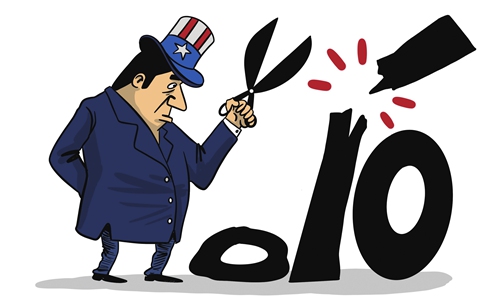HOME >> SOURCE
Fed focuses on short term, disregards long-term effects
By Li Chunding and Lin Xin Source:Global Times Published: 2020/3/17 22:23:11

Illustration: Luo Xuan/GT
The US Federal Reserve (Fed) on Sunday announced an interest rate cut and quantitative easing (QE) program, which shocked global markets.
The sudden drastic interest rate cut and liquidity release has taken the global markets by surprise. The Fed gave the explanation of countering the negative impact of the viral outbreak, supporting the US economy, stabilizing employment and maintaining an inflation target.
However, the measures needed the most amid the coronavirus pandemic are disease prevention and the improvement of medical supplies and conditions.
QE will support companies and individuals with more capital, but once the outbreak intensifies, extra liquidity cannot save the economy and employment. Quite the contrary, flooding the market with liquidity can only have an adverse influence.
The downward pressure on the US economy and stock market turbulence due to the coronavirus outbreak are the deeper reasons for the drastic QE move. Plunging US stock markets have halted trading three times so far in March.
Another incentive for Fed to move is pressure from the White House. After the stock market dive last week, US President Donald Trump repeatedly called out the Fed and urged it to lower interest rates, saying the Fed "must be a leader, not a very late follower."
The reason Trump is anxious about interest rates is that the pandemic, which could lead to a sharp turn in the US economy and equity market, will affect his chances in the presidential election. In order to create an image of economic health, the coronavirus under control, employment growing and stable financial markets, so that he can get a second term, Trump appears to be like a drowning man who clutches at a straw. Given the disease control measures the White House has been issuing recently, it appears that Trump is desperate to find a short-term economic stabilizer to take credit for re-election, completely disregarding long-term economic growth.
The US slashed interest rates to near zero and brought back QE, which will theoretically boost investors' confidence and stop the market from being panicking. QE could also help companies and individuals get through liquidity difficulties, and hereby produce more medical supplies and equipment to fight virus.
In reality, the capital market does not buy it. Those moves could stimulate economic growth and create jobs, but while the pandemic is spreading across the world, the stimulation will only be limited. Beside, QE can easily lead to inflationary pressure and asset bubbles, which create shaky financial markets or even financial crises.
In terms of China, the opportunities brought by the Fed's move outweigh the challenges. On the one hand, a lower federal funds rate may direct more capital to China where the interest rate is higher. While the coronavirus is mostly under control in China, the liquidity released by the US could assist the recovery and revival of the Chinese economy, as well as stabilize the capital market.
On the other hand, the QE will increase aggregate demand, which may be good for China's exports. But too large a supply of US dollars may add financial risk to the Chinese economy in the long run by pushing up asset prices and creating bubbles.
Li Chunding is a professor and head of the Institute of International Economics at China Agricultural University. Lin Xin is a PhD candidate with the College of Economics and Management at China Agricultural University. bizopinion@globaltimes.com.cn
Posted in: EXPERT ASSESSMENT